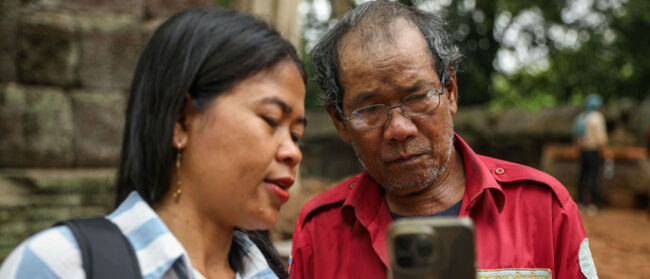On a small patch of land in the heart of Dili, enclosed by a ring of palm trees and a stone’s throw from Timor-Leste’s first shopping mall, almost 30 men and boys stood around a blood-stained cockfighting pit.Two cock handlers were in the centre of the square platform, thrusting their respective birds at one another, stirring some fighting instinct. A fast-talking youth ran around the pit, collecting dollar bills from the spectators. I gave him $10 and pointed to the white cock. All bets are double or nothing, he explained, before cracking a confident smile. “Good choice,” he said. “I bet on that one too.”
Suddenly one of the cock handlers thrust his bird in my direction. A clove cigarette dangling from his lips, the middle-aged man with a solemn face pointed to the ten-centimetre spur fastened to the animal’s left leg. “But don’t touch,” he warned. The spurs are covered in poison. “If it cuts you, you die,” he added, not joking.
During two hours spent at the arena, this warning was repeated by several other spectators who usually eyed the malae (foreigner) with either amusement or indifference.
The fight started. The two handlers grasped their cocks with both hands before throwing them down on the earthen floor. A second or two passed without the birds flinching. Then they launched at one another. Slicing and pecking. Screeching and flapping.
Every fight is a raucous affair. The crowd bellows and blusters, and as the cocks fumble at one another the crowd rushes in and out, pulsing like a single organism, trying to avoid the spurs while getting as close to the action as possible.
Exactly how the winning cock is decided is not always clear and, for a so-called blood sport, there is relatively little blood.
Some of the fights last ten seconds; others go on for more than a minute. Exactly how the winning cock is decided is not always clear and, for a so-called blood sport, there is relatively little blood. One match-up was stopped after one of the cocks started limping.
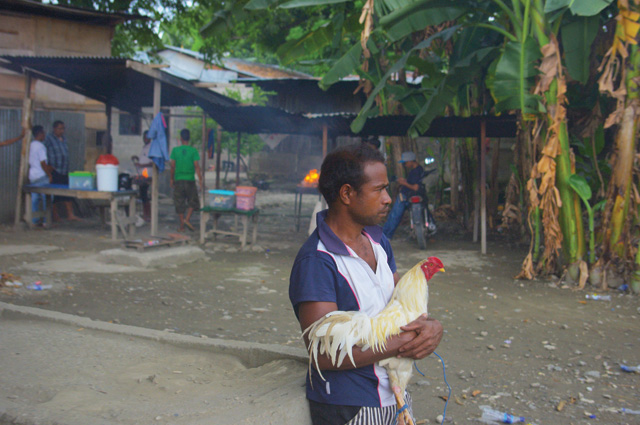
After a fight ends silence descends on the pit while the winning bets are paid out and cigarettes are lit. Soon the awaiting cock handlers begin the process again, shoving their birds at one another, ascertaining if they would make a fair fight.
The youthful bookie returned with my winning $20 and a few words: “In my country cockfighting is very important. It is part of our culture, our history. Some people say it’s cruel. But I don’t care.”
He also claimed that white cocks are better around midday as they wake earlier than others, but by the afternoon it is better to gamble on speckled birds because they wake later and have more energy.
Cockfighting – or manu futu – is an integral part of Timor-Leste’s culture and history. In rural areas, contests regularly take place at Sunday markets. In Dili one can expect a cockfight daily at one of the capital’s three pits – they usually take place after 5:00pm to attract a post-work crowd.
It is generally believed that cockfighting started in Timor-Leste hundreds of years before Portuguese colonisers arrived at the beginning of the 16th Century. Today, cockfighting is enjoyed by all levels of society. “The thing about cockfighting is that everyone does it,” explained the young bet collector. “Some are really poor; others have enough money. But also the rich come too – a government minister will come later.”
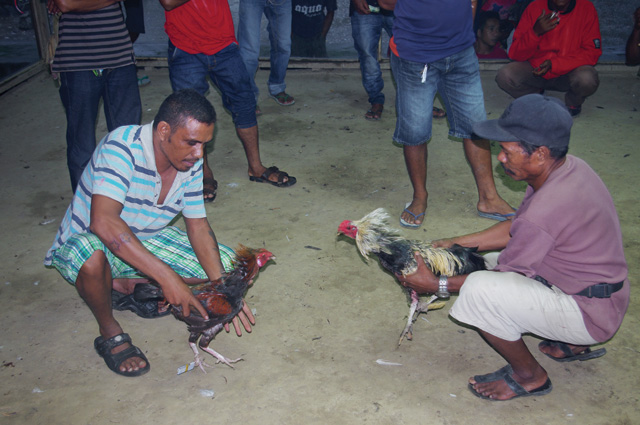
Despite its legal status and widespread popularity, there is little in the way of academic or journalistic study into the history and culture of cockfighting in Timor-Leste.
While the famed anthropologist Clifford Geertz brought Indonesian cockfighting to the world’s attention in his seminal essay Notes on the Balinese Cockfight, David Hicks is one of the few English-language academics to study cockfighting in the Southeast Asian nation.
A professor in the department of anthropology at Stony Brook University in the US, he is a leading expert on East Timorese culture and beliefs, and his paper, “Blood, Violence and Gender Alignment: Cockfighting and Kickfighting in East Timor”, published in the Cambridge Journal of Anthropology in 2006, offers by far the most accurate picture of the pursuit.
According to Hicks, before the Portuguese colonisation of Timor-Leste, East Timorese males would define their masculinity, courage and force through headhunting expeditions, which involved pursuing and beheading members of rival tribes. However, after the colonial powers put an end to this custom, “the celebration of masculinity found its most explicit outlet in narratives depicting bloody violence and in the ritualised sport of cockfighting”, Hicks wrote.
In fact, the word asuwa’in in the local Tetum language means both a warrior who has taken an enemy’s head and a cock that has killed another in the pit.
Cockfighting also provides young men with a rite of passage. “The procedure by which a male enters manhood commences at adolescence when his father presents him with a cock of his own,” Hicks wrote. “According to traditional custom, until a young man marries, he should not enter his cock in competition. Thus his cock may not kill nor, in former times, could he shed blood in headhunting.”
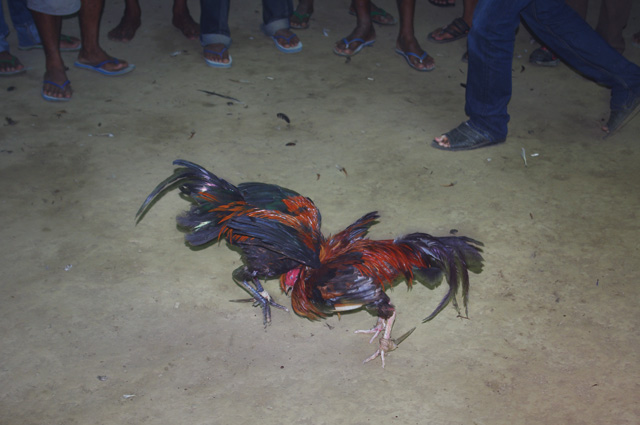
However, not everyone is as enthralled by cockfighting’s cultural significance. A 2012 report by Phyllis Ferguson, a consultant for the United Nations Development Programme, identified cockfighting, or more specifically the gambling that accompanies it, as a factor that contributes to impoverishment and domestic violence.
At the cock pit, it was not uncommon to see men bet more than $20 on each fight. There are also anecdotal claims from locals that for higher-ranking matches, individuals can wager hundreds of dollars each on single fights. The local NGO La’o Hamutuk estimates that the average monthly income per person in rural areas is less than $50. In Dili, the average is slightly more.
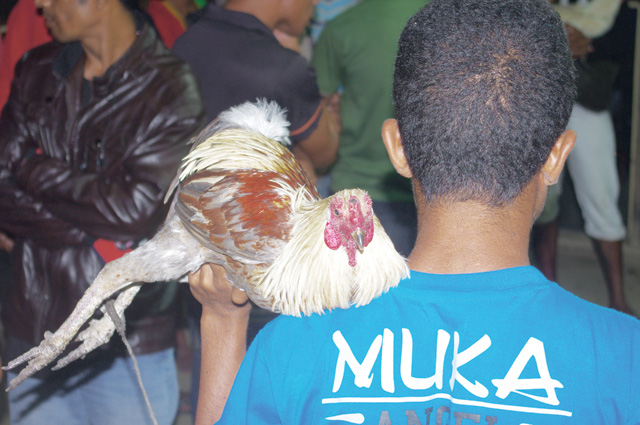
There are also concerns about who runs the cockfights. A local source, who requested anonymity, explained that cockfighting in Dili is big business. “There are a number of groups that run cockfighting in the capital,” he explained. The main ones, he added, are 7-7, which is widely described as a “gang”, and PSHT,
a martial arts group. In Timor-Leste, the recent history of gangs and martial arts groups is complex.
They can include anyone from government ministers down to unemployed youths and many originated during the fight for independence, sometimes providing clandestine support to the struggle. Though not all groups are violent, a significant chunk of the population are affiliated in some way and a number of groups have been made illegal.
“The police are also heavily involved in cockfighting, as are members of the army,” the source said, adding that recently the level of gang influence over cockfights has diminished, largely due to the “heavy involvement of the police who provide protection [from rival groups] and, I suspect, run it themselves”.
“Yes, there are problems. Some people gamble too much, and that is not good for the family,” said Platao Lebre, a local tour guide and Southeast Asia Globe’s way into the fight. “But cockfighting is not bad. It is part of our culture, and even if someone tried to stop it, the people would do it anyway.”


